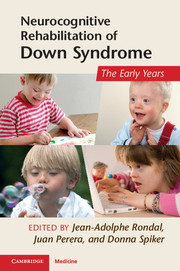Book contents
- Frontmatter
- Contents
- List of contributors
- Preface
- Acknowledgments
- Section 1 Definition, history, methodology, and assessment
- Section 2 Genetics, brain, and animal models
- Section 3 Pharmacological and medical management and treatment
- Section 4 Early development and intervention
- 10 Developmental models as frameworks for early intervention with children with Down syndrome
- 11 Aspects of motor development in Down syndrome
- 12 Memory development and learning
- 13 Prelinguistic and early development, stimulation, and training in children with Down syndrome
- 14 Speech perception, stimulation, and phonological development
- 15 Goal-directedness as a target for early intervention in Down syndrome
- 16 The role of parents of children with Down syndrome and other disabilities in early intervention
- Section 5 Therapeutic perspectives
- Conclusions
- Index
- References
12 - Memory development and learning
Published online by Cambridge University Press: 05 July 2011
- Frontmatter
- Contents
- List of contributors
- Preface
- Acknowledgments
- Section 1 Definition, history, methodology, and assessment
- Section 2 Genetics, brain, and animal models
- Section 3 Pharmacological and medical management and treatment
- Section 4 Early development and intervention
- 10 Developmental models as frameworks for early intervention with children with Down syndrome
- 11 Aspects of motor development in Down syndrome
- 12 Memory development and learning
- 13 Prelinguistic and early development, stimulation, and training in children with Down syndrome
- 14 Speech perception, stimulation, and phonological development
- 15 Goal-directedness as a target for early intervention in Down syndrome
- 16 The role of parents of children with Down syndrome and other disabilities in early intervention
- Section 5 Therapeutic perspectives
- Conclusions
- Index
- References
Summary
Introduction
Distinct cognitive profiles among individuals with mental retardation (MR) of different etiologies have recently been documented. Studies from different laboratories, for example, have demonstrated a complex neuropsychological profile in people with Down syndrome (DS), with atypical development in the cognitive and linguistic domains (for a review see Vicari et al., 2004; Vicari, 2006). However, a quite different pattern is often reported in other syndromes such as Williams syndrome (WS). This is another genetic condition, less frequent but equally characterized by MR and typified by a number of severe medical anomalies, such as facial dysmorphology and abnormalities of the cardiovascular system (Bellugi et al., 1999). Differently from DS, WS children often show marked impairment in certain spatial abilities (especially praxic–constructive) and relative preservation of both productive and receptive language, at least concerning the phonological elements (Vicari et al., 2004).
Within the neuropsychological approach to MR, the study of memory and learning is particularly relevant. In fact, altered development of the memory function can seriously interfere with adequate maturation of general intellectual abilities, and thus with the possibility of learning and modifying behavior on the basis of experience.
This chapter is dedicated to reviewing the neuropsychological literature and recent experimental studies on memory and learning development in people with DS, reporting their memory capacities and deficits. Consistent with a neuropsychological approach, distinct memory profiles can be traced to the characteristics of the DS brain development and architecture.
- Type
- Chapter
- Information
- Neurocognitive Rehabilitation of Down SyndromeEarly Years, pp. 164 - 174Publisher: Cambridge University PressPrint publication year: 2011



